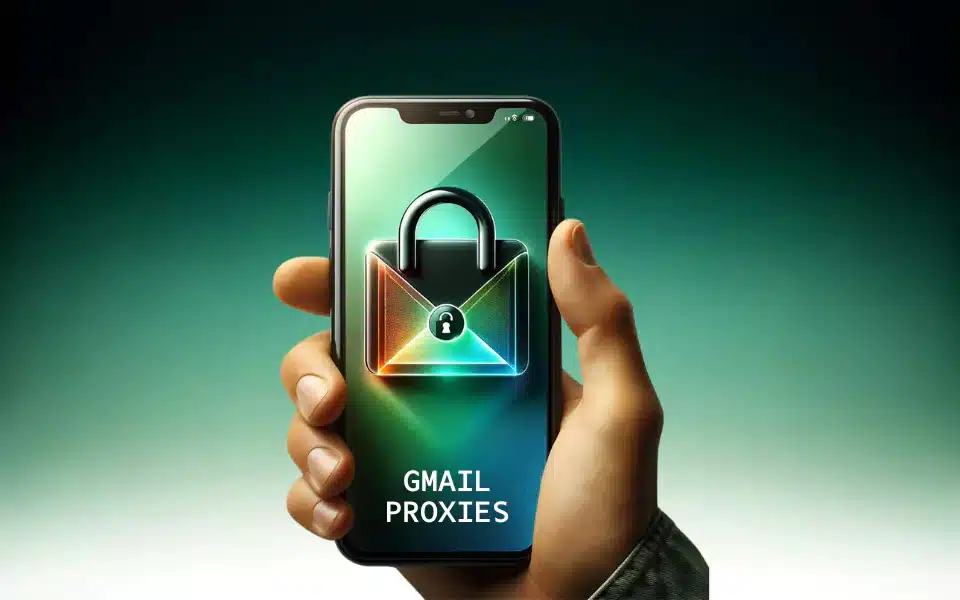Gmail restrictions can be frustrating, whether you’re trying to access your inbox from a different location, bypass workplace filters, or simply protect your online privacy. This is where a Gmail proxy offers a powerful solution. By acting as an intermediary between your device and Gmail’s servers, a Gmail proxy allows you to mask your IP address, overcome regional blocks, and boost your security.
However, not all Gmail proxies are created equal. To ensure an optimal experience, look for a proxy service that prioritizes reliability, robust security measures, and ease of use.
In this article, we will give you the results of our experts’ research and knowledge on the topic of gmail proxies, how they work, and where to buy the best options.
Table of Contents
- What Is A Gmail Proxy & How Does It Work?
- Why You Might Need a Gmail Proxy: Common Use Cases
- Gmail Proxy vs. VPN: How To Choose?
- How To Use a Gmail Proxy: Step-by-Step Setup Guide
- Security & Privacy Tips
- Common Challenges and Solutions
- How to Set Up a Proxy for Gmail in Outlook?
- V6Proxies: Your Go-To Solution for Mailing Proxies
- FAQs: Clearing Up Doubts
What Is A Gmail Proxy & How Does It Work?
Think of a Gmail proxy as a special set of computer glasses. When you put them on, Gmail can no longer see your real IP address (your unique internet identifier). Instead, Gmail sees the IP address of the mailing proxy server. This gives you flexibility and a layer of protection:
- Location Flexibility: If Gmail is blocked where you are, the proxy’s glasses can make it appear as if you’re connecting from a different part of the world.
- Identity Protection: Your real IP address can reveal a lot about you. Using a proxy helps obscure this information, making it harder for hackers, websites or services to track your online activity back to your precise location.

Benefits: Your Key Advantages
- Bypass Restrictions: Whether you’re facing workplace firewalls, country-wide bans, or other hurdles, Gmail proxies help you gain access.
- Enhanced Privacy: Keep your online persona shielded, adding an extra security layer against hackers and unwanted tracking.
- Streamline Account Management (Ideal Client Focus): Marketers and businesses can efficiently manage multiple Gmail accounts without encountering restrictions from Gmail.

Why You Might Need a Gmail Proxy: Common Use Cases
From unblocking Gmail to protecting your identity, gmail proxies can help in many situations you face including:
1. The Frequent Traveler
Encountering access barriers to Gmail while abroad can be frustrating. This situation often arises due to regional restrictions on Google services or temporary network issues. In countries where Google’s services are restricted by local laws, a proxy or a VPN can help regain access. However, it’s important to be mindful of the legal landscape regarding internet use in your location, as bypassing regional restrictions might have legal implications.
2. Breaking Workplace Blocks
In environments where access to personal email services like Gmail is restricted, a proxy might seem like a straightforward solution to stay connected. Yet, it’s crucial to consider the context of such restrictions—often in place for security or productivity reasons.
3. Privacy Enthusiasts
For those looking to minimize their online footprint, employing a proxy can offer a level of anonymity by hiding your real IP address during email checks.
4. Marketers and Multiple Accounts
Managing multiple accounts on Gmail is a common requirement for marketers running diverse campaigns or businesses. Proxies can assist in avoiding Gmail’s security alerts triggered by simultaneous account logins from a single IP address.
Gmail Proxy vs. VPN: How To Choose?
Both proxies and VPNs are valuable tools for masking your IP address and enhancing your online freedoms, but they serve slightly different purposes and offer varying degrees of protection. Here’s when a Gmail proxy might shine, with considerations for an informed choice:
1. Based on Focus on Specific Services
If your primary objective is to access Gmail without changing the way you connect to other services, a proxy can be a suitable option. Proxies can indeed be configured to route only specific traffic—such as your emails through Gmail—allowing the rest of your internet activity to remain unaffected.
This targeted approach can help maintain your normal internet speed for activities not related to Gmail. However, it’s critical to understand that while proxies can redirect your traffic to bypass restrictions or conceal your location, they might not encrypt your data, potentially leaving it vulnerable to interception.
2. Based On Affordability
For users who need a solution specifically for accessing Gmail, especially in situations where a VPN might seem like an unnecessary expense for their entire internet connection, a Gmail-specific proxy can appear as a more cost-effective alternative.
It’s true that proxies can be cheaper than VPN services; however, this cost difference often reflects the level of security and privacy protection provided. VPNs typically offer comprehensive encryption for all your internet traffic, making them a more secure option for protecting your data online.
How To Use a Gmail Proxy: Step-by-Step Setup Guide
Note: The exact steps will depend on the type of proxy you choose and your specific browser. The most common method is manual configuration within your browser.
1. Find Your Proxy Details: Your proxy provider (like V6 Proxies) will give you an IP address, port number, and a username and password for authentication.
2. Browser Settings:
- Chrome: Settings –> System –> Open your computer’s proxy settings
- Firefox: Options –> Network Settings –> Settings
- Other Browsers: Most modern browsers have similar proxy settings menus.
3. Select Your Proxy Type: Choose the relevant type (HTTP, SOCKS, etc.) matching your provider’s instructions.
4. Input Details: Enter the proxy server’s IP address, port number, and authenticate if necessary.
5. Test it Out: Visit Gmail; it should load fast with the proxy masking your real IP.

Security & Privacy Tips
- Choose a Reputable Provider: This is crucial! Opt for services like V6Proxies, known for high-quality mailing proxies and privacy protection.
- Rotate Proxies: Overusing a single Gmail proxy can lead to detection. Switch IPs for optimal security.
- Clear Browser Data: Cookies and history can still contain traces of your real IP. Clear them regularly.
Common Challenges and Solutions
- Slow Connection: It’s normal for free proxies to slightly decrease speeds. Choose high-quality paid proxies to minimize this, and ensure it’s not your own internet connection causing the issue.
- Blocked IPs: Gmail itself might detect and block proxies’ IP addresses. Reputable providers constantly add and rotate new IPs to unblock gmail.
- Authentication Issues: Double-check you’ve entered your proxy’s username and password correctly if they are required.
How to Set Up a Proxy for Gmail in Outlook?
Using Gmail with Outlook requires a bit of extra configuration to connect through your proxy. Here’s a step-by-step breakdown of how to set everything up:
Prerequisites
- A Gmail account with IMAP enabled: Check your Gmail settings to ensure this is turned on.
- Your Proxy Details: You’ll need the proxy server’s IP address, port number, proxy type (likely SOCKS5), and any necessary authentication (username/password) from your provider.
Steps
- Open Outlook: Launch your Outlook application.
- Access Account Settings: Navigate to “Tools” -> “Accounts”.
- Add a New Mail Account: Select “Add” -> “Mail”.
- Provide Your Information: Enter your name and full Gmail address.
- Select IMAP: Choose “IMAP” as your incoming mail server type.
- Input Gmail & Proxy Settings:
- Incoming Mail Server (IMAP): imap.gmail.com
- Outgoing Mail Server (SMTP): smtp.gmail.com
- Proxy Settings: This differs slightly based on Outlook version. Look for settings related to proxies within the “Accounts” area, then specify your proxy type, IP address, and port number.
- Authentication: Enter your Gmail username and password.
- Advanced Settings:
- Test Your Connection: Send a test email to yourself within Outlook to verify that everything is working correctly.

V6Proxies: Your Go-To Solution for Mailing Proxies
Earlier, we highlighted the importance of reliability, security, and ease of use when choosing a Gmail proxy. That’s where V6Proxies mailing proxies stands out. Our focus on mailing proxies allows us to tailor solutions directly to the needs of Gmail users:
- Residential Proxies for Top-Tier Trust: Our vast network of mailing residential IP addresses makes it near impossible for Gmail to detect you’re using a proxy, minimizing account restrictions.
- Unmatched Security: We take protecting your personal information seriously. Robust encryption and strict privacy practices ensure your online activities stay confidential.
- Seamless Setup: Our intuitive setup guides and dedicated support team help even those unfamiliar with proxies get up and running quickly.
FAQs: Clearing Up Doubts
Aren’t proxies slow?
While free and low quality proxies can add a bit of latency, V6Proxies prioritizes high-speed connections, ensuring a smooth Gmail experience.
Are Gmail proxies safe?
When working with a reputable provider like V6Proxies, you can rest assured your data is protected. Avoid free or shady services.
Do I need technical knowledge to use V6Proxies?
Absolutely not! We provide simple guides and are always ready to assist you in the setup process.
Related articles:
- Tags:
- mailing proxies



